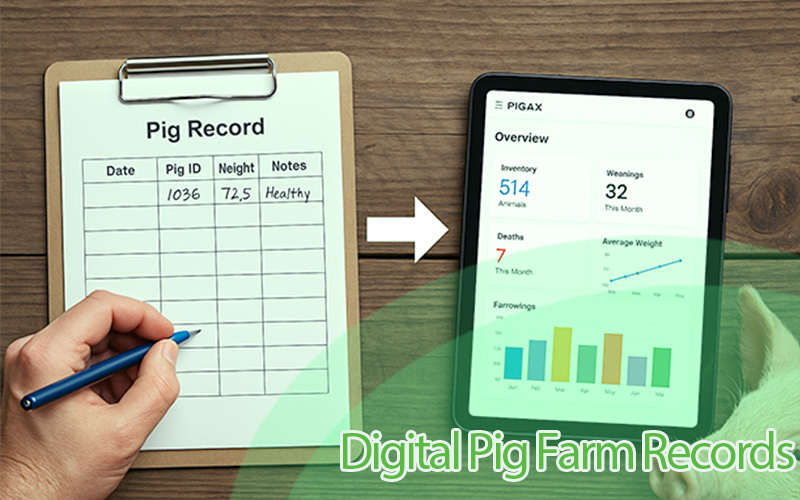5 Ways to Improve Pig Data Integrity
Data is the backbone of effective management and operational efficiency in every piggery business. Accurate data can lead to improved decision-making, higher productivity, and increased profitability. However, when data integrity is compromised, the consequences can be dire, impacting everything from daily operations to long-term strategic planning.
This blog explores the pivotal role of data integrity in pig farming, identifies common sources of inaccuracies, and provides practical solutions to ensure the reliability of your data.
Causes of Pig Data Inaccuracy
Understanding these causes is the first step toward implementing effective solutions. Here's an extensive explanation of each major cause of inaccurate pig data:
1. Manual Data Entry Errors
Manual data entry is one of the most common sources of data inaccuracies in the piggery business. This method relies heavily on human input, which can lead to typos, transposition errors (where numbers are swapped), or omissions where data is not recorded at all. The risk of error increases with the volume of data being entered and the complexity of the information required. For instance, during busy periods like feeding or treatment, the chances of making errors are significantly higher.
2. Outdated or Inadequate Systems
Many piggeries may still rely on outdated systems or basic spreadsheets for data management. These systems might not be designed to handle the volume or complexity of data typically generated in modern pig farming operations. Outdated software may lack the features that help check for inconsistencies or automate data capture, making it difficult to maintain accurate records. Furthermore, these systems may not integrate well with new technologies, leading to silos of information where data across systems are inconsistent.
3. Lack of Training
The accuracy of data also heavily depends on the competency of the staff handling the information. Inadequate training on the importance of data integrity and how to correctly input data into management systems can lead to significant inaccuracies. This is particularly true in the piggery business, where data variables are numerous and frequently changing, such as feed intake levels, growth rates, and health indicators. Staff might not fully understand how or why data should be recorded, leading to incorrect or incomplete data entries.
4. Environmental Factors
The physical environment where data collection occurs can also impact data accuracy. For instance, harsh environmental conditions in pig farms such as high humidity, dust, and temperature fluctuations can affect the functioning of technological devices used for data recording. Manual data recording done under such conditions can also be less accurate, as these conditions can lead to discomfort or haste in recording information.
5. Technical Failures
Hardware failures, software crashes, and data corruption can lead to significant data loss or inaccuracies. For example, if a system unexpectedly shuts down due to a power outage or hardware malfunction while data is being entered or processed, it may result in incomplete or corrupt data. Regular maintenance and updates are required to minimize these risks, but they can be overlooked in the busy operational schedule of a pig farm.
6. Human Error
Beyond simple data entry mistakes, human error can also involve misinterpretation of data, incorrect data analysis, or even the mislabeling of data fields. Staff might record the right value in the wrong place, or apply the wrong units of measure, which can lead to large discrepancies in data analysis and reporting.
How to Improve Pig Data Integrity
Now we know some of the causes of inaccurate data in the piggery business, we can now discuss some measures to resolve and improve the accuracy of data we get on our piggery operation.
1. Implement Advanced Farm Management Software
To combat the challenges of data inaccuracy, implementing advanced farm management software is a crucial step. Modern software solutions are designed to handle the complexities of pig farming, offering features such as automated data entry, real-time updates, and comprehensive reporting tools. These systems reduce human error and provide a centralized database that helps in making informed decisions quickly and efficiently.
2. Utilize IoT Devices for Real-Time Data Collection
The integration of Internet of Things (IoT) devices in pig farming has revolutionized data collection processes. Sensors and devices can monitor a range of conditions, including temperature, humidity, and pig health indicators like weight and feed intake. This technology provides precise, real-time data that is automatically logged, minimizing manual errors and enhancing the accuracy of the farm's data repository.
3. Conduct Regular Training for Staff
Ensuring that all personnel are well-trained in both the use of new technologies and the importance of data accuracy is fundamental. Regular training sessions can help staff understand the best practices in data collection and entry. Workshops can also be used to demonstrate the consequences of data inaccuracies, further emphasizing the importance of their role in maintaining data integrity.
4. Establish Routine Data Audits
Routine data audits are essential to maintain the integrity of data over time. These audits help identify inconsistencies and errors that might occur during data entry or collection. By regularly reviewing the data, farms can take immediate corrective actions, thus maintaining the reliability of their information. Scheduling audits monthly or quarterly, depending on the size and scale of the operation, is a recommended practice.
5. Create a Culture of Accountability
Creating a culture where every team member feels responsible for the accuracy of the data they handle can significantly enhance overall data integrity. Encouraging open communication about discrepancies and fostering an environment where staff are praised for diligence can lead to more accurate data handling. Accountability should be a core value championed from the top down.
Pig Data Integrity with Pigax
Pigax, a specialized software solution, can be a game-changer in the quest for impeccable data integrity. It addresses common data inaccuracies through features like automated syncing, error detection algorithms, and user-friendly interfaces. Pigax not only integrates effortlessly with existing systems but also provides training modules to help staff make the most of its capabilities. By using Pigax, farms can ensure that their data is not only accurate but also secure.
Conclusion
The integrity of data in pig farming is not just about record-keeping; it's about building a foundation for sustainable and profitable operations. By implementing robust software solutions, utilizing modern technologies, training staff effectively, conducting regular audits, and fostering a culture of accountability, farms can significantly improve their data management practices. These steps not only prevent the pitfalls of inaccurate data but also enhance the overall health and productivity of the livestock.




